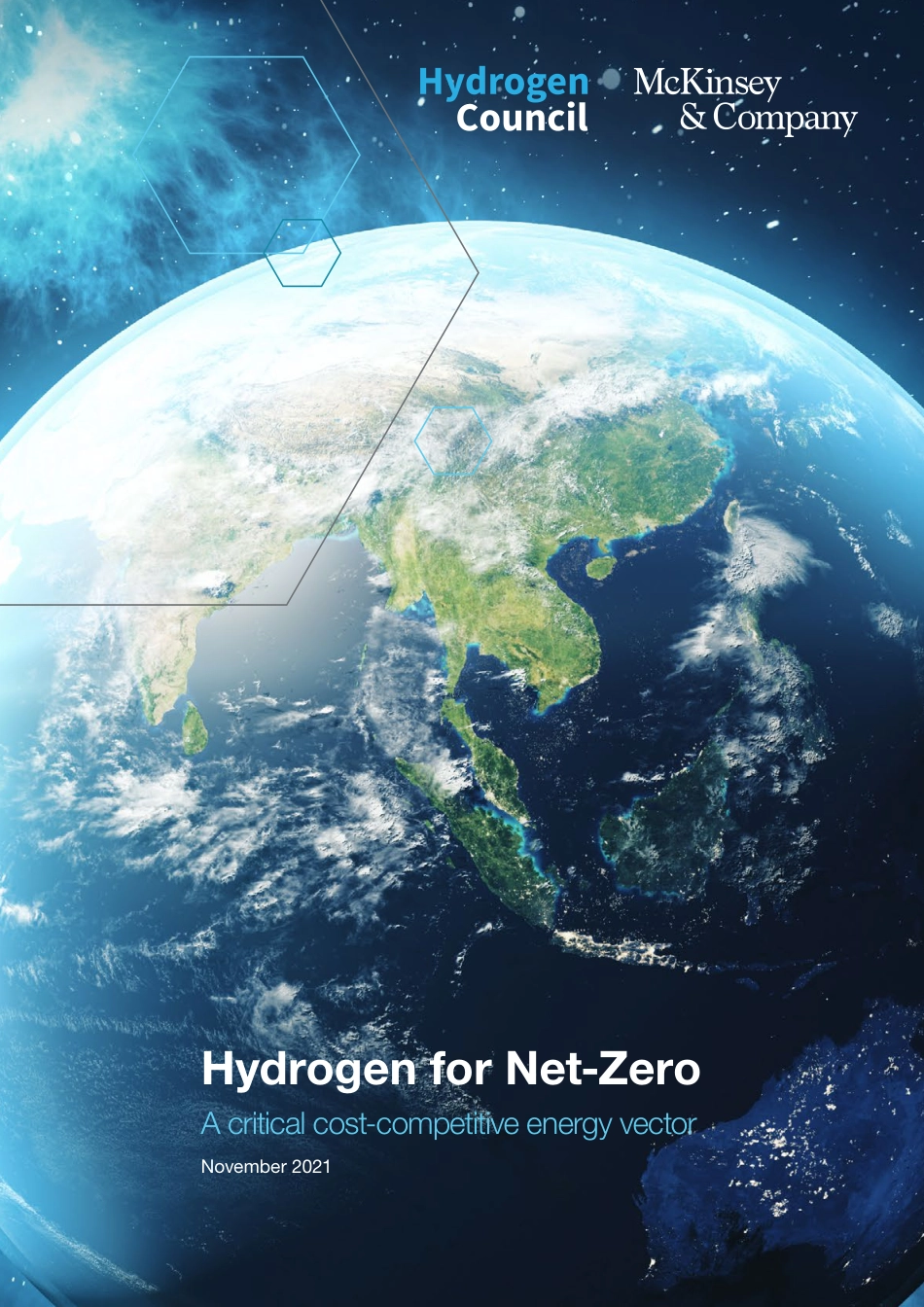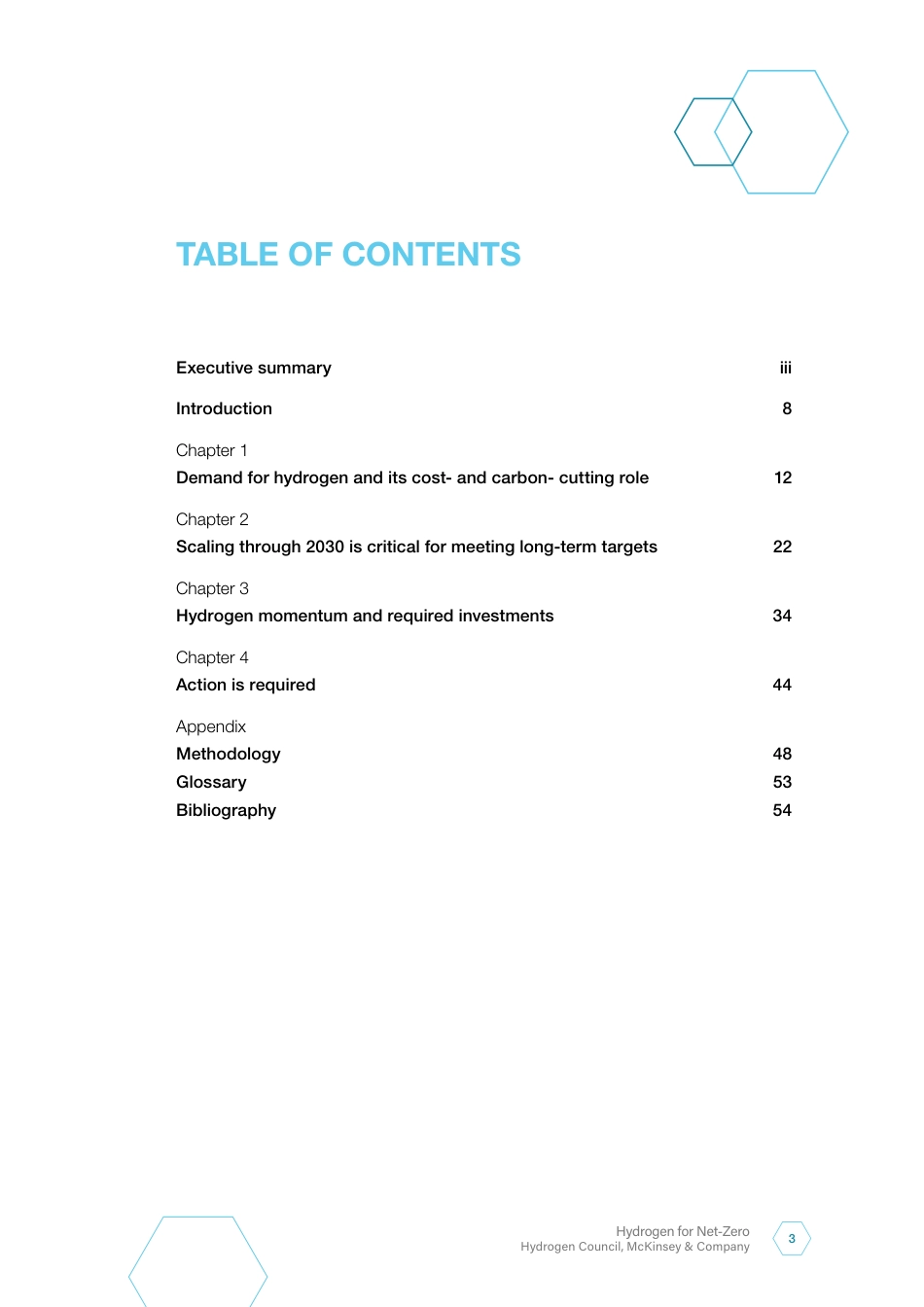HydrogenforNet-ZeroAcriticalcost-competitiveenergyvectorNovember2021PublishedinNovember2021bytheHydrogenCouncil.Copiesofthisdocumentareavailableuponrequestorcanbedownloadedfromourwebsite:www.hydrogencouncil.comThisreportwasauthoredbytheHydrogenCouncilincollaborationwithMcKinsey&Company.Theauthorsofthereportconfirmthat1.Therearenorecommendationsand/oranymeasuresand/ortrajectorieswithinthereportthatcouldbeinterpretedasstandardsorasanyotherformof(suggested)coordinationbetweentheparticipantsofthestudyreferredtowithinthereportthatwouldinfringetheEUcompetitionlaw;and2.Itisnottheirintentionthatanysuchformofcoordinationwillbeadopted.WhilstthecontentsoftheReportanditsabstractimplicationsfortheindustrygenerallycanbediscussedoncetheyhavebeenprepared,individualstrategiesremainproprietary,confidentialandtheresponsibilityofeachparticipant.Participantsareremindedthat,aspartoftheinvariablepracticeoftheHydrogenCouncilandtheEUcompetitionlawobligationstowhichmembershipactivitiesaresubject,suchstrategicandconfidentialinformationmustnotbesharedorcoordinated–includingaspartofthisReport.HydrogenforNet-ZeroHydrogenCouncil,McKinsey&Company2TABLEOFCONTENTSExecutivesummaryIntroductionChapter1Demandforhydrogenanditscost-andcarbon-cuttingroleChapter2Scalingthrough2030iscriticalformeetinglong-termtargetsChapter3HydrogenmomentumandrequiredinvestmentsChapter4ActionisrequiredAppendixMethodologyGlossaryBibliographyiii8122234444853543HydrogenforNet-ZeroHydrogenCouncil,McKinsey&CompanyExecutivesummaryivHydrogenforNet-ZeroHydrogenCouncil,McKinsey&CompanyHydrogeniscentraltoreachingnetzeroemissionsbecauseitcanabate80gigatonsofCO2by2050Hydrogenhasacentralroleinhelpingtheworldreachnet-zeroemissionsby2050andlimitglobalwarmingto1.5degreesCelsius.Complementingotherdecarbonizationtechnologieslikerenewablepower,biofuels,orenergyefficiencyimprovements,cleanhydrogen(bothrenewableandlowcarbon)offerstheonlylong-term,scalable,andcost-effectiveoptionfordeepdecarbonizationinsectorssuchassteel,maritime,aviation,andammonia.Fromnowthrough2050,hydrogencanavoid80gigatons(GT)ofcumulativeCO2emissions.Withannualabatementpotentialof7GTin2050,hydrogencancontribute20%ofthetotalabatementneededin2050.aThisrequirestheuseof660millionmetrictons(MT)ofrenewableandlow-carbonhydrogenin2050,equivalentto22%bofglobalfinalenergydemand.Hydrogeniscriticalinenablingadecarbonizedenergysystem.Itfacilitatestheintegrationofrenewablyproducedenergybecausehydrogencanstoreenergy,provideresilience,andtransporthighvolumesofenergyoverlongdistancesviapipelinesandships.Hydrogenallowsenergycompaniestotapextremelycompetitive,butotherwise“stranded”renewableenergyinremotelocations.Thisacceleratestheenergytransitionasitallowsmorerenewablestobebuilt.Finally,becausehydrogencanbeproducedfromelectricityandusedas,orconvertedinto,fuels,chemicals,andpower,theproductionofhydrogenfromelectricitywillconnectandfundamentallyreshapecurrentpower,gas,chemicals,andfuelmarkets.Intermsofenduses,hydrogeniscriticalfordecarbonizingindustry(e.g.,asfeedstockforsteelandfertilizers),long-rangegroundmobility(e.g.,asfuelinheavy-dutytrucks,coaches,long-rangepassengervehicles,andtrains),internationaltravel(e.g.,toproducesyntheticfuelsformaritimevesselsandaviation),heatingapplications(e.g.,ashigh-gradeindustrialheat),andpowergeneration(e.g.,asdispatchablepowergenerationandbackuppower).China,f...



 VIP
VIP VIP
VIP VIP
VIP VIP
VIP VIP
VIP VIP
VIP VIP
VIP VIP
VIP VIP
VIP VIP
VIP